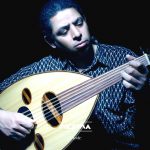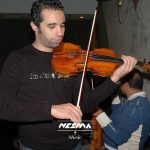Toola
Moddathir Aboul Wafa
Moddathir Aboul Wafa invites us to rediscover Egyptian music and enjoy it.
Recorded exclusively with acoustic instruments by some of the most brilliant Egyptian musicians, this disc presents a large variety of styles; classical oriental compositions, traditional music, and marvellous improvisations, included the last theme which fusions with the Latin samba rhythms.
- Artist:Moddathir Aboul Wafa
- Title: Toola
- Catalogue ref.: ND0701
Upon seeing him pick up his oud and play a melody by Maukeb El Nagham, I felt an uncontrollable sensation grow inside me; I knew at that moment that this meeting was the beginning of a fruitful artistic adventure that would culminate in this marvellous disc.
Moddathir Aboul Wafa (born in Cairo, 1962) is a composer, arranger and oud player. Alongside his work as a teacher at the Arabic Music Institute, he participates as performer and writer-composer for important Arabic music groups which perform in Egypt and in festivals around the world.
Particularly noteworthy is his collaboration with the master Abdou Dagher in the scoring and performance of his music.
When we met Moddathir, we immediately had the feeling that we all shared the same fundamental ideas regarding the music we wanted to make. He soon understood our worries; while the overwhelming majority of Arabic music productions today are focused on the singers, making much use of electronic sounds, our interests were focused on traditional and classical Arabic music. We wanted to record independent music, not mainstream, and music in which the instrumental melodic performances and the rich Arabic chords would once again hold a privileged position. We aspired for the majestic sound heard in classically-trained performers of the mid-20th century.
The music that Moddathir has created and we have recorded on this album is at the same time modern and traditional, innovative and respectful of the teachings of the great Egyptian composers. For those who know Egypt, the first five pieces that make up this disc may evoke its distinctive scenery, landscapes, and scents. The last piece included here, which gave name to the album, is a feat of expression of the richness of Arabic instrumental performance and the extraordinary possibilities it has to offer in fusion with other musical genres. Here I primarily mean with jazz fusion which, in its day, mixed light, jovial Latin rhythms so well.”
“Some of the most brilliant Egyptian musicians have joined forces with Moddathir for the creation of this disc, adding their personal touch. I join Moddathir in thanks to all of these musicians and especially to Khamis Henkesh, without whose friendship and involvement this project would not have been possible. We also gratefully acknowledge Ehab Nabil and his studio team at Ammer Sound for the warm welcome they showed us as well as the magnificent work they did. We cannot finish without giving special mention to the great masters Hassan Sharara and Abdou Dagher for accepting our invitation to perform, giving us the delight of floating along with their superb improvisations.
— Eric Godfroid
Original compositions by Moddathir Aboul Wafa.
Catalogue Ref. : ND0701
©2007 Nesma Music
Track listing:
1. Mawkeb El Nagham (9:02)
2. El Leil Wel Nil (7:26)
3. Al-Qahira El Adima (10:06)
4. Fi Samaa Al-Musika (9:57)
5. Samaa Hos (8:32)
6. Samba Toola (6:55)
Total playing time: 49:40
Mawkeb El Nagham (Procession of melodies), represents, for the composer, a royal procession. The lush melodies accompanied by elegant, complicated rhythms accentuate the majesty of the procession, which celebrates the grandeur of the king: the oud.
This innovative composition was written over a Tahmila as base, a traditional musical form which consists of the repetition of a motif performed by the whole orchestra, through which improvised solos are woven. On one hand, the peculiarity of this Tahmila lies in the 9/4 time rhythmic sequence created by the composer for this work, and, on the other hand, in the improvised second half which is not restricted to any time signature. Here, the instruments that perform the improvisations are the oud and the cello, and the use of the latter for improvisation is another innovation for a Tahmila performance.
El Leil wel Nil (The Night and the Nile), reflects the impression of a person strolling along, approaching the Nile shore to admire the serenity of the Egyptian night, followed by the emotional charge resulting from contemplating the different scenes visited. This overture (Eftetahia), composed in the Cord scale, can be formally divided into four parts of 4/4 time, with a final fragment in 7/4 time. In the first part, the composer made use of string instruments to reflect the serene flow of the river waters at sunset. The nay (Arabic flute) represents the nightingale’s song as he flies over the river waters, venerating God with his beautiful song. In the second part, Bambi and Malfouf rhythms represent a ship embarking over the Nile. The seaman’s voyage carries us to the third part. We find ourselves in a wedding celebrated in one of the luxurious dance halls along the Nile shore. The accordion and the kanoun both express the party’s exuberance. The journey ends with a classical Arabic recital in an old palace at the river’s edge. The oud and the kanoun are accompanied by the instrumental ensemble and percussion instruments in a classic 7/4 time signature which concludes the piece harmoniously.
El Qaheyra El Adima (Old Cairo), the name of the neighbourhood where the composer was born and raised, recreates a wedding scene as they are celebrated today in the city’s most popular neighbourhoods. As a well-known Egyptian writer put it, we are all “children of our neighbourhood.” Good humour and melancholy are mixed in this piece, inseparable components of the Egyptian soul. Examining the piece further, we find five distinct parts. The accordion improvisation reveals the poetic, popular atmosphere of Cairo. Then, the accordion together with the rest of the ensemble introduces the main melody with Wahda Kibira and Maksoum rhythms. This makes way for the celebration and invitation to the party. The third part consists of an accordion and percussion improvisation which represents the groom’s dance with a stick, demonstrating his happiness and virility to the guests. From a nearby balcony, the bride enjoys the scene with her friends. In the fourth part, the bride enters the house and dances to the sound of the kanoun, here expressing feminine sensuality. Finally, all the guests join together to bid the bride and groom farewell.
Fi Samaa Al-Musika (In music heaven), expresses the feeling of liberation and letting-go that goes along with unlimited freedom, far from a rigid environment that gives rise to boredom. From the composer’s viewpoint, the composition reflects the artistic evolution that Egypt underwent until reaching its maximum splendour in the mid-20th century. This piece, masterfully arranged, is structured in four parts, with a repeating section after each part. The main scale used here is Hogaz, in its many forms. The Samai Thakil rhythm in 10/4 is transformed in the fourth part into a Saraband in 3/4 time.
Samaa Hos (Keep quiet and listen), celebrates the camaraderie of the musicians playing together, an essential ingredient in the creation of art. It is in this charmed moment when magic runs through the artists’ bodies and the spectators keep quiet and listen to better appreciate the poetry and the spell cast upon them. This composition is performed by a modern Takht ensemble, which includes solos from all the instruments of the ensemble with the exception of the bass. The piece allows the soloists free interpretation, as the camaraderie and interaction between players is an essential element in the expression of a traditional Takht (small ensemble).
For a joyous finish, Samba Toola connects us directly with the spirit of samba and jazz. Performed in the Tabriz scale (C Major), it is, for Moddathir, a real artistic experience. He composed this piece while dancing and playing with his three-year-old daughter Toola; the girl’s joy shines through the piece. The pianist Akram Sharkawy collaborated with Moddathir on the arrangements of this piece.
Featuring Musicians:
Oud Moddathir Aboul Wafa
Kanoun Maged Sorour (# 1-5)
Nay Mohamed Fouda (# 1-3), Reda Bedeir (# 4,5)
Accordion Farouk Mohamed Hassan (# 2,3), Moddathir Aboul Wafa (# 6)
Violin Moustafa El Moogui, Mohamed El Moogui, Hazem El Kasabgi,
Moustafa Abou Sheffa, Ahmed El Kasabgi, Wagdi Ghonem,
Samir Rashad, Ibrahim El Radio (# 1-3),
Moustafa Abdel Nabi (# 4,5),
Hassan Sharara (# 6), Abdou Dagher (solo # 6)
Violoncello Emad Ashour, Yasser Taha (# 1-5)
Hassan Moataz (# 6)
Countrebass Beshir Awes
Tabla, Dohola Khamis Henkesh
Doff, Bendir Hesham El Arabi (# 1-2), Khamis Henkesh (# 3-5)
Req Hesham El Arabi
Triangle, Haguer Hesham El Arabi (# 1)
Drums Amr Khairy (# 6)
Congos, Bongos, Percussion Diaa Tass (# 6)
Credits:
Music composed and arranged by Moddathir
Aboul Wafa except Samba Toola, arranged by
Akram El Sharkawy (combo) and Moddathir
Aboul Wafa (strings and oriental instruments).
Recording, mixing and mastering by Ehab Nabil.
Produced by Julia Salmerón and Eric Godfroid.
Recorded in November December 2006
at Ammer Sound Studio, Cairo.





















